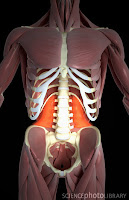We’ve been talking a lot about low back pain, and I’ve showed you some great stretches that might help relieve your low back pain, particularly if the source is muscular. Tight low back muscles can be a major, if not the primary, source of low back pain. But sometimes tight low back muscles are only part of the equation–the muscles of the abdominal core may also be weak, causing instability of the lower back and pelvic regions.
I have showed you a fantastic exercise to strengthen the core called plank pose, and for overall firming and stability it can’t be beat. However, the rectus abdominus muscles are also important, especially for athletes. These abdominal muscles are the ones most hardcore exercisers strive to develop; they are the six-pack of ripped abs fame.
Aside from the aesthetics, however, having strong rectus abdominus muscles are important posturally, and they help maintain the integrity of the internal organs by keeping them fixed firmly in the abdominal cavity. But as muscles of movement, the rectus abdominus flexes the torso–that is, they bring the chest toward the pelvis or vice versa, depending on which end is fixed (or both toward one another if neither end fixed)
How is this important to athletes? Anytime one needs to get up off the ground–as in MMA fighting, wrestling, Ultimate Fighting (PrideFC) or any other martial arts competition–the rectus abdominus is involved. As an endurance muscle, a weak rectus abdominus can fatigue leaving you unable to get up. Think body blows in any fight game. The idea is to wind the opponent. Because the rectus abdominus also assists in breathing, particularly when winded, you can see how important it is for these muscles to be fit.
In the video below, I demonstrate the best exercises to strengthen the abdominal muscles. It’s a standard crunch, but with a few critical nuances. Everybody and their mother knows how to do one version or another of the crunch, but so many are rife with biomechanical faults that I encourage you to watch below and refine your crunches–you’ll get the most out of the exercise if you follow the details I demonstrate. You will need to master these two movements–the abdominal hollow and the pelvic tilt–before you start, so give them each up to a week of practice (depending on your fitness level) before starting on the crunches. And then enjoy.














